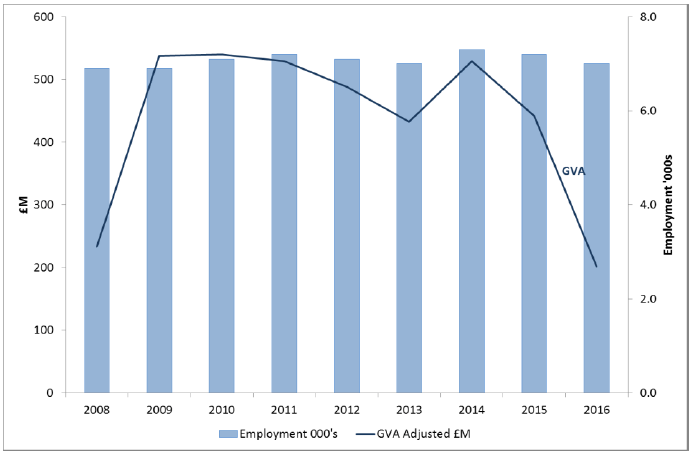Scotland's marine economic statistics 2016
The publication presents economic statistics for industrial categories defined as part of the marine sector.
7. Shipbuilding
7.1 Introduction
Shipbuilding is represented in this report by the SABS SIC codes 30.1: Building of ships and boats and 33.15: Repair and maintenance of ships and boats . As part of the SABS annual publications, Scottish Government published a Shipbuilding Profile where the Scottish shipbuilding sector is analysed in relation to UK economic sectors.
Shipbuilding data can fluctuate considerably due to the spasmodic nature of the business. It can take a number of years to build and sell a ship, so purchase figures may be higher in some years and turnover higher in other years. Company re-structuring within the industry has also contributed to year-on-year fluctuations in statistics for the industry. The ONS estimation methodology produces regional estimates for both Scottish and non-Scottish business sites from single business returns which cover all UK activity. A few business sites can therefore make a large difference to the outputs. The SIC codes covered in the shipbuilding profile have a very slightly narrower definition than the codes supplied for this Marine sector.
7.2 Key economic points
In 2016 shipbuilding generated £202 million GVA: accounting for 0.15 % of the overall Scottish economy, and 5 % of the marine economy.
In terms of employment, ship building provided employment for 7,000 workers in 2016, contributing 0.3 % to total Scottish employment, and 9 % of the marine economy employment.
The SABS Shipbuilding Profile reports that in 2016 the shipbuilding sector accounted for around 3% of turnover and 2% of GVA in Scottish manufacturing as a whole. It also considers Scottish shipbuilding in the context of total UK output of the shipbuilding industry, where the Scottish sector accounted for around 12% of GVA.
The SABS supporting notes on the Shipbuilding Profile explain that changes in a small number of (large) companies can have a have a very marked effect, particularly on sectoral and local authority figures, from one year to the next.
At this disaggregate level of analysis (4-digit SIC), particular caution should be exercised in looking at year-on-year changes for the sector. Instead, figures should be used to chart long-term trends.
7.3 Shipbuilding - trends
Table 11 : Ship building - GVA, turnover, employment and GVA per head, 2008 to 2016 (2016 prices)
| Year | GVA £M | Turnover £M | Employment Headcount 000's | GVA Per Head £ |
|---|---|---|---|---|
| 2008 | 233 | 914 | 6.90 | 33,821 |
| 2009 | 538 | 1,448 | 6.90 | 77,975 |
| 2010 | 540 | 1,560 | 7.10 | 76,049 |
| 2011 | 529 | 1,532 | 7.20 | 73,514 |
| 2012 | 489 | 1,610 | 7.10 | 68,812 |
| 2013 | 433 | 1,276 | 7.00 | 61,820 |
| 2014 | 529 | 1,448 | 7.30 | 72,498 |
| 2015 | 442 | 1,668 | 7.20 | 61,326 |
| 2016 | 202 | 1,001 | 7.00 | 28,829 |
From 2015 to 2016 the shipbuilding GVA dropped by over half, though the spasmodic nature of the business should be taken into account here, and SABS caution noted.
The longer term trend, between 2008 and 2016, shows shipbuilding GVA (adjusted to 2016 values) dropped by 14% from £233 million to just over £200 million, though Figure 9 shows that there has been considerable fluctuation over that period. Over the 9 years of comparable SABS statistics, employment has remained relatively stable at around 7,000 workers.
Figure 9: Shipbuilding - GVA and employment, Scotland, 2008 to 2016 (2016 prices)

7.4 Shipbuilding – by geography
The SABS Shipbuilding profile reports that the top three local authority areas in 2016 (Aberdeen City, Fife and Glasgow City) accounted for 75% of employment, 84% of turnover and 60% of GVA in the sector. It is not possible to supply a full individual list of local authorities with shipbuilding activity for confidentiality reasons.
Contact
There is a problem
Thanks for your feedback